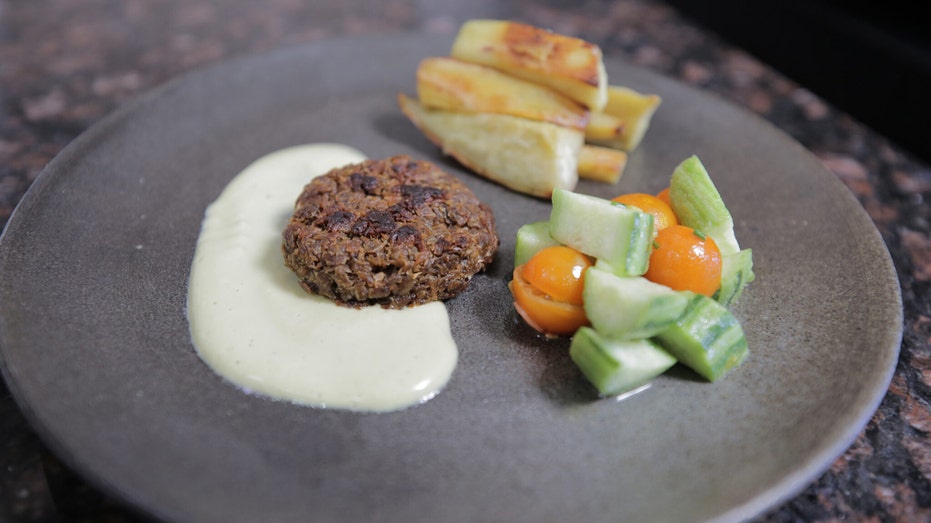
A new study details how scientists are using the fungus Neurospora intermedia to ferment foods that were once considered waste. These new foods are being served at a New York restaurant.
A New York restaurant is serving fungus.
While Neurospora intermedia might not appear on the menu, it’s a key ingredient used to make certain meals in the kitchen at the Michelin-starred Blue Hill at Stone Barns in New York. It’s part of a collaboration between California researchers and chefs at Blue Hill and in Copenhagen to develop new foods using the fungus.
A study done at the University of California, Berkeley, and published in the journal Nature Microbiology detailed how the fungus Neurospora intermedia is being used to ferment foods that were previously considered waste.
FOOD AT COLLEGE GETS HIGH-TECH BOOST WITH FIRST ROBOTIC KITCHEN IN UNIVERSITY SETTING
Leading the research is Vayu Hill-Maini, PhD, who recently joined Stanford University as an assistant professor of bioengineering.
Hill-Maini has a culinary background. He told Fox News Digital he wanted to “address pressing global challenges in our food system” – namely, the amount of food that goes to waste. (See the video just below.)
“There’s really an urgent need to redefine and reimagine what we eat and how we produce that food to ensure that our planet is still habitable and that we have a good food supply for future generations,” Hill-Maini said.
About 30% of all the food grown in the United States is “wasted or lost in some way,” Hill-Maini said.
AS HUNGER NUMBERS INCREASE, FOOD PANTRIES IN AMERICA MORE IMPORTANT THAN EVER
“And this isn’t just eggshells and kale stems in your trash bin,” he said. “It’s really on an industrial scale.”
Wasted food has an impact on food security and access, he said. “This is perfectly edible material. If we’re wasting it — well, we’re not feeding people.”
His research sought solutions to these issues.
“One really powerful way has been using fermentation to take these waste products — then turn those wasted ingredients into something new,” he said.
Hill-Maini did extensive research on Neurospora intermedia, a fungus cultivated from soy pulp and traditionally used in Indonesia to make a food called oncom.
The fungus uses pectin and cellulose during fermentation.
To put his research to the test, Hill-Maini needed a willing participant.
He found two.
One was Alchemist in Copenhagen. The other was Blue Hill at Stone Barns within the Stone Barns Center for Food and Agriculture in Pocantico Hills, New York.
Andrew Luzmore, a chef and director of special projects at Blue Hill, told Fox News Digital the farm-to-table restaurant has been using Neurospora intermedia for about two years. (See the video at the very top of this article.)
Among the fungus-crafted menu items is a toast made from stale rice bread and a dessert made from rice custard.
Luzmore said the rice bread, “after a day, because it’s a gluten-free bread — it’s just rock hard.”
But when reimagined with Neurospora intermedia, it has a French toast-like texture and “this great, cheesy, super-delicious savory flavor.”
Uncooked, the fungus has “orange fuzz” on it, Luzmore said, which he admitted doesn’t look appetizing.
But there is a metamorphosis that occurs when cooked.
OVERNIGHT FRENCH TOAST COMPLETE WITH LAYER OF BERRIES OFFERS AN ‘ELEVATED’ BREAKFAST DISH
“Then that fuzz becomes this deep orange, really beautiful golden brown and delicious color,” Luzmore said.
There are other fungus foods out there, of course, notably mushrooms. And popular cheeses made of fungus include brie and blue cheese.
“We know from ancient human history that fungi can make delicious foods,” Hill-Maini said.
So what makes Neurospora intermedia different?
“What we thought is: What if we actually turned things a little bit around and thought about instead of, you know, using fungi to ferment all these very nice ingredients — could we use fungi to ferment waste and turn it into food?” Hill-Maini said.
CHEESE DISCOVERED INSIDE COFFIN WITH ANCIENT MUMMIES DATES BACK THOUSANDS OF YEARS
“Meaning, the waste can now become delicious, it can become nutritious, and we can address those challenges and sustainability of food security.”
For the skeptics out there, Hill-Maini noted that this fungus has undergone “rigorous scientific research.”
“It’s not just a random fungus that we found in the soil,” he said.
Luzmore is hopeful his involvement with Neurospora intermedia has a greater good.
“Yes, we’re serving this, in the most-immediate term, in our restaurant,” he said.
“But longer term, the point is to not have it just exist in the four walls of a very expensive restaurant,” said Luzmore.
“It is to develop ideas that have relevance to the greater food culture and can be enjoyed at every single level of eating – home eating to restaurant eating.”
CLICK HERE TO SIGN UP FOR OUR LIFESTYLE NEWSLETTER
The hard part, he added, is figuring out the best way to educate others about “a food that we believe really has tremendous value, has tremendous potential — and get people excited about it.”
It’s helpful, he said, that “there’s been this newfound exaltation of fermented foods.”
“To me, the real story is bringing together two historically siloed professions of scientists, people like Dr. Vayu, and chefs who are wearing a different type of white coat and bringing them into the same room together,” Luzmore said.
For more Lifestyle articles, visit www.foxnews.com/lifestyle
Hill-Maini agreed with that notion.
“It’s really awesome here to have real-world producers and leading chefs say, ‘Hey, I want a part of this research, too,'” he said.
“That’s a way for us to bridge from the lab all the way to the table and actually ensure that what we study and learn reaches people.”





